Income and Expenditure Accounts Technical Series
Remaining useful service life ratios of non-residential capital stock
Archived Content
Information identified as archived is provided for reference, research or recordkeeping purposes. It is not subject to the Government of Canada Web Standards and has not been altered or updated since it was archived. Please "contact us" to request a format other than those available.
Overview
Statistics Canada has developed a new statistical product titled Remaining useful service life ratios of non-residential capital stock as an extension of its existing Stock and Consumption of Fixed Non-residential Capital (SCFNRC) program. It provides users with annual data from 2009 to 2014 for 19 high-level industries for a variety of detailed non-residential assets. There are 33 specific assets included, classified into four major groups; non-residential building assets (8), engineering assets (11), machinery and equipment assets (11) and intellectual property product assets (3).
The main benefit of this product is that it provides information on the relationship between the timing and the average age of infrastructure investments and their associated expected service lives and it also provides additional information, for example, on the state of infrastructure in Canada. While this product can provide insight on investment spending deficits or surpluses, within and across asset classes, it is not an all-inclusive assessment of the state of the infrastructure stock in Canada. Data gaps on the state of Canada’s infrastructure remain, which require the development of additional statistical products in the future to address specific information needs.
Methodology
The remaining useful service life ratio product is an extension of the SCFNRC program and uses the same concepts, classifications and estimation methods. The calculations start with an accumulation of investment from a variety of sources at Statistics Canada, including survey data (capital and repair expenditures, building permits, oil and gas activities, etc.) in addition to employment indicators, trade statistics and a plethora of price indexes. This allows for the estimation of a detailed investment time series, in nominal and real terms.
Once the investment flows are determined, the value of assets retired from the stock each year is calculated by incorporating a discard function and average service life by asset type. Investment flows are accumulated and discarded over time, giving rise to a gross stock of assets. The average age of investment is then derived as the weighted age of all investments remaining in the gross stock at year end.
The service life is the average time, in years, that a non-residential asset is expected to be productive and in use. Of course, some assets do not fulfill their expected service lives, while others might surpass them. This is accounted for in the discard function, which assumes the probability of an asset to retire or be discarded is based on a truncated normal distribution with a minimum of 50% and maximum of 150% of their expected service life, and a standard deviation of 25% of their mean service life. Different assets have different mean service lives and different discard patterns. At Statistics Canada, asset service lives are collected directly from business survey respondents using the Capital and Repair Expenditures Survey and provides a fairly comprehensive profile that was published in The Canadian Productivity Review, an update on depreciation rates for the Canadian Productivity Accounts (2015).Note 1 These resulting service lives and depreciation rates were implemented in the SCFNRC program. Chart 1 highlights service lives for selected assets for illustrative purposes.
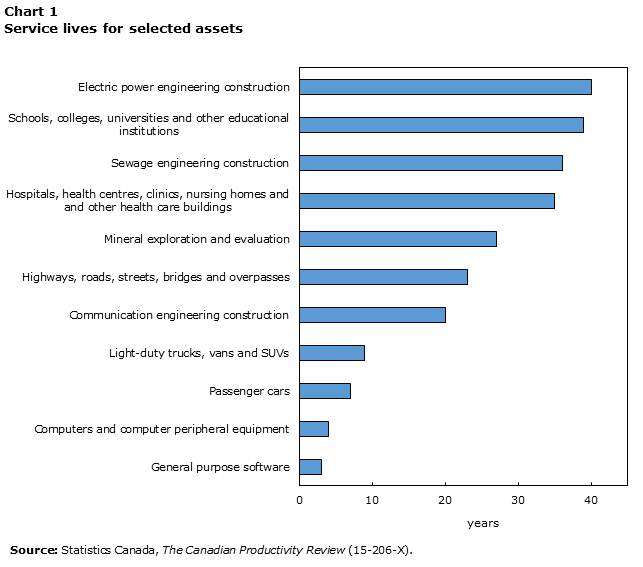
Data table for Chart 1
| Service life | |
|---|---|
| years | |
| General purpose software | 3 |
| Computers and computer peripheral equipment | 4 |
| Passenger cars | 7 |
| Light-duty trucks, vans and SUVs | 9 |
| Communication engineering construction | 20 |
| Highways, roads, streets, bridges and overpasses | 23 |
| Mineral exploration and evaluation | 27 |
| Hospitals, health centres, clinics, nursing homes and other health care buildings | 35 |
| Sewage engineering construction | 36 |
| Schools, colleges, universities and other educational institutions | 39 |
| Electric power engineering construction | 40 |
| Source: Statistics Canada, The Canadian Productivity Review (15-206-X). | |
Lastly, the remaining useful life, which is the difference between the average age of the investment spending and their expected service life, is then divided by the expected service life, creating a ratio that indicates the percentage of the asset class that remains. For example, if the average age of investment in highways is 6 years and the expected service life is 30 years, the ratio is (30 − 6) ÷ 30 = 80%. The higher the ratio, the more useful life remains. This ratio permits a comparison of one asset class to another and can enable analysis of where investment is most required.
Figure 1 provides a simplified example of how the average age of an investment is calculated. Assume that a given asset has a 4 year average service life and an investment of $100 has been made annually for 7 years. To calculate the average age of investment spending for this asset in 2015, the following steps are required. Given its service life and discard function, a $100 investment in 2010 has only 7% of its value that remains in year 2015 and is at age 5. A $100 investment in 2011, will have a $32 value remaining and is at age 4, $68 at age 3 for the same amount of investment made in 2012, etc. The summation of all the entries in the 2015 column represents the total gross stock, which in this example is valued at $400 and is comprised of a combination of younger and older assets.
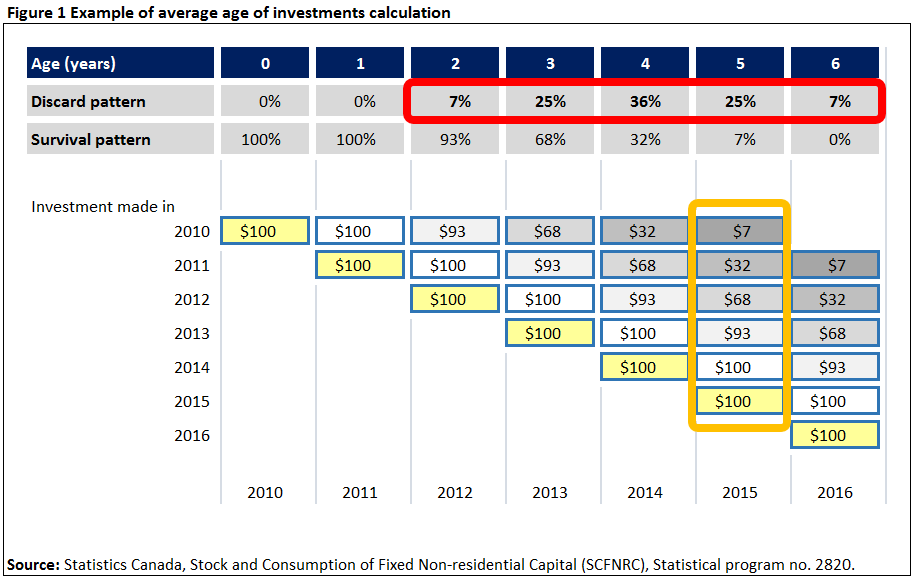
Description for Figure 1
This figure provides a simplified example of how the average age of investment is calculated. Assume that a given asset has a 4 year average service life and an investment of $100 has been made annually for 7 years. To calculate the average age of investment spending for this asset in 2015, the following steps are required. Given its service life and discard function, a $100 investment in 2010 has only 7% of its value that remains in year 2015 and is at age 5. A $100 investment in 2011, will have a $32 value remaining and is at age 4, $68 at age 3 for the same amount of investment made in 2012, etc. The summation of all the entries in the 2015 column represents the total gross stock, which in this example is valued at $400 and is comprised of a combination of younger and older assets.
Source: Statistics Canada, Stock and Consumption of Fixed Non-residential Capital (SCFNRC), Statistical program no. 2820.
Once the gross stock is calculated, the ages of investment spending are incorporated and are shown in Figure 2. The remaining value of investment made up to and including the year 2015 is multiplied by its age and its aggregate becomes the sum of the age weights (in this example 653). The average age of investment shown on Figure 2 is the sum of the age weights divided by the total gross stock (653 ÷ 400 = 1.6) meaning the average age of the cumulated total stock for investment over the 2010 to 2015 period is 1.6 years. An alternative presentation is to divide the remaining useful life (2.4), which is the difference between the average age (1.6) and the expected service life (4), by the expected service life (4), yielding 60%, representing the share of the total stock that remained as of 2015.
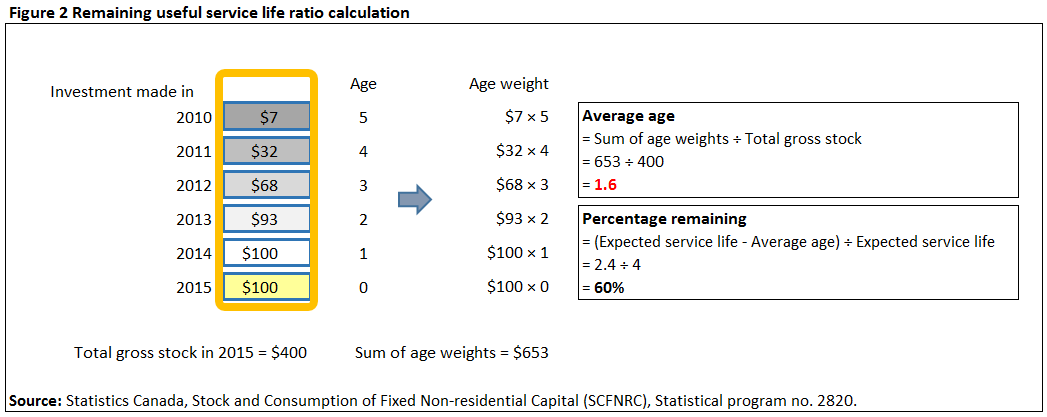
Description for Figure 2
The average age of investment shown on this figure is the sum of age weights divided by the total gross stock (653 ÷ 400 = 1.6) meaning the average age of the cumulated total stock for investment over the 2010 to 2015 period is 1.6 years. An alternative presentation is to divide the remaining useful life (2.4), which is the difference between the average age (1.6) and the expected service life (4), by the expected service life (4), yielding 60%, representing the share of the total stock that remained as of 2015.
Source: Statistics Canada, Stock and Consumption of Fixed Non-residential Capital (SCFNRC), Statistical program no. 2820.
In the calculation, an adjustment is also made to take into account the assumption that new assets are generally placed in service at midyear.
Similar to the average age calculation, the expected service lives of detailed assets are aggregated using a weighted average of the service lives, weighted by the investment value of the gross stock. This aligns the level of detail of the service lives to the investment flows.
Data limitations, interpretations and uses
Average ages, which are part of the numerators in the ratio calculation, are based on an economic model that uses an extensive data set and are only one indication of the state of investment in a given asset, and do not attempt to assess the actual physical shape or quality of each non-residential asset. The model includes certain assumptions, such as that each asset has a time-invariant expected service life and discard function. Other countries, such as the United States and Australia, have produced similar statistics and while they are sometimes labeled as “average age” they are not a true indication of the age of the physical assets themselves and have consequently been characterized as the “average age of weighted investment spending on non-residential assets”. Due to the weighted nature of the calculation, a higher proportion of investment spending in recent periods on a given non-residential asset relative to previous periods will result in a young average investment age. The asset stock might have a significant portion in decay, nearing the end of its service life or even still being used beyond its estimated service life. It is therefore important to note that the average age calculation is not intended as a precise indicator of the quality or state of the asset and consequently, caution should be used in the interpretation of these data. In some cases, there are results that indicate low average ages in particular asset categories that may still require investment spending, or conversely, whose quality is not indicative of the current actual state one might observe if the actual asset was inspected.
Investment spending includes new construction or purchases, but also includes all additions, major renovations, conversions and alterations to an existing asset. This investment might be made to improve an asset’s productivity or to extend its life, make it safer for use or adopt more current technology to meet new demands.
The implementation of the remaining useful service life ratio creates an indicator of the non-residential stock that can be interpreted as an indicator of the capital spending deficit or surplus required to maintain the stock, by allowing the ratio to serve as a benchmark. Its reduction over time will indicate an absence or inadequate investment commitment while conversely, its rise might indicate an over-investment relative to other asset classes. The degree to which the ratio of the average age of investment approaches the expected service life of the asset changes through time before it is considered in deficit or surplus is not included in these results, as this determination would require the consideration of other factors and would vary by asset category.
As noted previously, this new data product does not fill all information needs and should therefore be used in conjunction with other products as they become available to evaluate the physical state and determine priorities in infrastructure management. While those assets closely related to infrastructure are highlighted in this analysis and whose findings are described below, there are a variety of non-infrastructure related assets included in this data set that could also have been given prominence.
Key findings
This section describes some key findings of the remaining useful service life ratios of non-residential capital stock analysis. The first, shown in Chart 2, indicates that there was sufficient investment in all asset categories in the 2009 to 2012 period and into 2013 for the waterworks engineering asset as the percentage of the asset remaining useful service life ratio was increasing. Moreover, a cessation or reduction in investment occurred in 2013 or 2014. Secondly, these findings indicate that the investment in waterworks engineering has exceeded that of highways, roads, streets and bridges, which in turn has exceeded the investment in sewage engineering.

Data table for Chart 2
| Year | Highways, roads, streets, bridges and overpasses | Sewage engineering | Waterworks engineering |
|---|---|---|---|
| percent | |||
| 2009 | 63.8 | 63.2 | 69.5 |
| 2010 | 65.1 | 63.4 | 71.4 |
| 2011 | 65.8 | 63.9 | 72.6 |
| 2012 | 66.3 | 64.2 | 73.5 |
| 2013 | 66.1 | 63.8 | 73.9 |
| 2014 | 65.9 | 63.2 | 72.9 |
| Source: Statistics Canada, CANSIM table 031-0010. | |||
Charts 3 to 5 depict, by province, the average age of highways, roads, streets, bridges, and overpasses for 2014. The average age for all provinces and territories ranges from a low of just over 6 years in Alberta, to a high of just over 12 years in Prince Edward Island, with the national average equaling around 8 years. These two provinces are shown separately in Chart 4 and Chart 5. To illustrate how dependent the average age is on investment spending, in Prince Edward Island non-residential asset spending has fallen sharply in the latter 3 years to under $20 million in 2014 after reaching a peak in 2011 of over $120 million, resulting in a higher average age. Conversely in Alberta, investment spending has been sustained at a high level of between $3 and $4 billion from 2010 to 2014 and is producing low average ages as a result. What is interesting to note, is that the lion’s share of investment spending in Canada in 2014 occurred in Alberta and Saskatchewan, pulling the Canadian national average age lower and diverging from the relatively smaller provinces and territories.
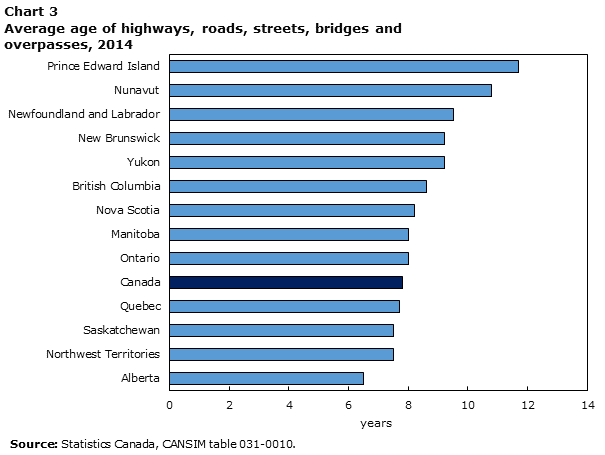
Data table for Chart 3
| Province | years |
|---|---|
| Alberta | 6.5 |
| Northwest Territories | 7.5 |
| Saskatchewan | 7.5 |
| Quebec | 7.7 |
| Canada | 7.8 |
| Ontario | 8.0 |
| Manitoba | 8.0 |
| Nova Scotia | 8.2 |
| British Columbia | 8.6 |
| Yukon | 9.2 |
| New Brunswick | 9.2 |
| Newfoundland and Labrador | 9.5 |
| Nunavut | 10.8 |
| Prince Edward Island | 11.7 |
| Source: Statistics Canada, CANSIM table 031-0010. | |

Data table for Chart 4
| Year | Investments |
|---|---|
| millions of dollars | |
| 2009 | 75 |
| 2010 | 79 |
| 2011 | 129 |
| 2012 | 66 |
| 2013 | 13 |
| 2014 | 17 |
|
Source: Statistics Canada, Stock and Comsumption of Fixed Non-residential Capital, Statistical program no. 2820. |
|
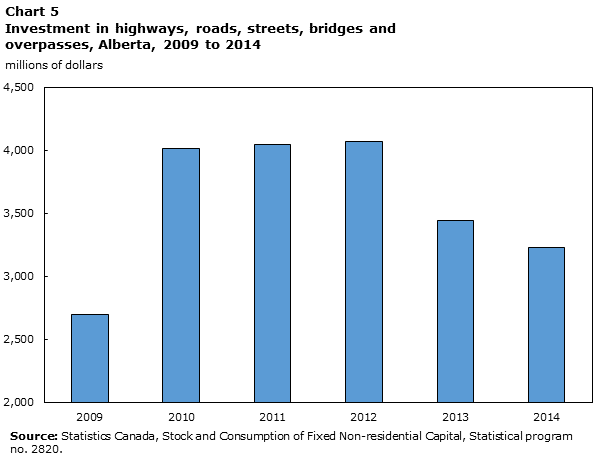
Data table for Chart 5
| Year | Investments |
|---|---|
| millions of dollars | |
| 2009 | 2,700 |
| 2010 | 4,010 |
| 2011 | 4,043 |
| 2012 | 4,069 |
| 2013 | 3,439 |
| 2014 | 3,228 |
| Source: Statistics Canada, Stock and Consumption of Fixed Non-residential Capital, Statistical program no. 2820. | |
Sewage engineering is another important non-residential asset class in Canada and the data suggests a dichotomous regional breakdown from 2009 to 2014 as shown in Charts 6 and 7. While the average age in Canada has remained stable at 13 years, there are clearly regions in Chart 6 that have improved their sewage infrastructure by lowering their average ages in the period through increased investment spending. In contrast, the provinces in Chart 7 show increases in average age over this time period, also reflective of lower recent investment expenditures relative to the past.

Data table for Chart 6
| Province | 2014 | 2009 |
|---|---|---|
| years | ||
| Saskatchewan | 11.9 | 13.9 |
| Alberta | 10.1 | 11.8 |
| Newfoundland and Labrador | 13.5 | 14.3 |
| Nova Scotia | 15.1 | 15.7 |
| New Brunswick | 14.7 | 14.8 |
| Canada | 13.3 | 13.3 |
| Source: Statistics Canada, CANSIM table 031-0010. | ||

Data table for Chart 7
| Province | 2014 | 2009 |
|---|---|---|
| years | ||
| Yukon | 18.3 | 18.1 |
| Prince Edward Island | 18.6 | 18.4 |
| Ontario | 13.3 | 13.0 |
| Quebec | 14.5 | 14.0 |
| Nunavut | 13.0 | 12.3 |
| British Columbia | 14.0 | 13.1 |
| Northwest Territories | 18.2 | 16.7 |
| Manitoba | 15.1 | 13.3 |
| Source: Statistics Canada, CANSIM table 031-0010. | ||
Conclusion
As indicated in the overview, these new estimates are an extension of the existing Stock and Consumption of Fixed Non-residential Capital (SCFNRC) program and provide a short historical time series of a variety of asset classes. The main benefit of this product is that it provides information on the relationship between the timing and average age of infrastructure investments and their associated expected service lives, providing additional information on Canada’s infrastructure. It is not an all-inclusive assessment of the state of the infrastructure stock in Canada and data gaps remain. However, if interpreted correctly, they can provide useful information about requirements for infrastructure and non-infrastructure asset investment. They can also be used as a benchmark to understand capital spending deficits or surpluses, changes over time can indicate when and where investment is required, in the context of the fiscal, economic and demographic landscape.
Note
- Date modified:

